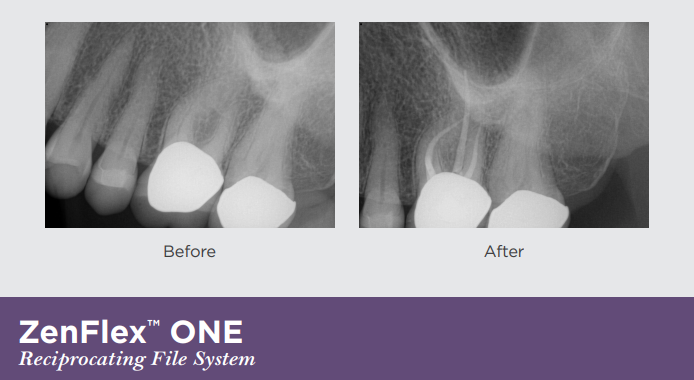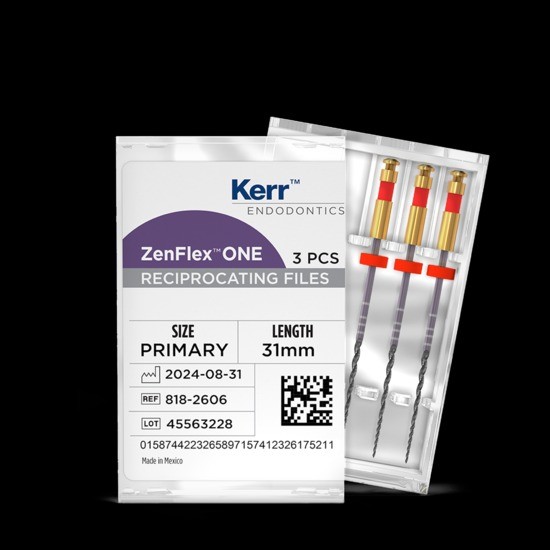Dr. Ferras Mashtoub, DDS is an endodontist who specializes in general, family, and cosmetic dentistry. Dr. Mashtoub is San Fernando Valley native, and after graduating from UCLA’s dental school, he continued to live and work in the area around Los Angeles, CA that he grew up in. He prides himself in his ability to put patients’ minds at ease by clearly explaining treatment, ensuring their comfort at every visit. This desire to continue learning and understanding has led him to the leading edge of dentistry and dental technology, exploring which tools offer new possibilities for advancing patient care.

The ZenFlex ONE Reciprocating File System
by Dr. Ferras Mashtoub
There are times when the most important part of dental procedure is choosing which filing system to use. You want to mix efficiency with patient comfort, and the first step is selecting the right tool for the job.
There are two main types of endodontic files used in root canal procedures: rotary and reciprocating files. Rotary files are used in a continuous clockwise motion to shape the canal, while reciprocating files use a back-and-forth motion to shape the canal.
Rotary Files vs. Reciprocating Files
Rotary files are known for their efficiency and speed, as they can remove dentin quickly and effectively. They are also less likely to break during use, which can save time and money. However, rotary files can generate more heat and debris, which can cause damage to the tooth and surrounding tissues.
Reciprocating files, on the other hand, are designed to reduce the risk of file separation and instrument fracture. They use a reciprocating motion to shape the canal, which can help reduce the amount of debris generated during the procedure. Reciprocating files are also less likely to generate heat, which can help preserve the tooth structure and reduce the risk of post-operative pain.

A Recent Patient Case
I recently had a patient present with temperature sensitivity in the upper left quadrant. The exam confirmed that tooth #14 was the source of symptoms and a diagnosis of symptomatic irreversible pulpitis was made. A pre-op CBCT was taken that confirmed presence of an MB2 canal that merged into the MB1.
1. Access was performed through the crown and all four canals were located.
2. An orifice opener file was initially used for each canal.
3. Followed by a standard #10 K-file which was able to navigate to full working length (as confirmed with an apex locator) in all canals except for MB1/MB2.
4. To achieve working length in MB1/MB2, I used a #3 Gates Glidden to open the canal orifice further and get a better straight-line access to the canals.
5. I also used the ZenFlex™ ONE with very light pressure to clear a path further into the canal, then I flushed it out with NaOCL. Next I used the #10 hand file and was able to reach full working length.
6. I then hand instrumented all canals to a #15 hand file.
7. With all canals comfortably instrumented to a size #15 hand file, I used the ZenFlex ONE in all canals.
Tip: I have found that if you are able to hand instrument to a size #15, the ZenFlex ONE will then be able to navigate the canal very safely and reliably as well. I use light pressure with up and down motion while the chamber is full of NaOCl and with RC-prep on the file. If I feel the file has stopped advancing, I will stop, flush out the chamber, hand instrument to length again (recapitulate) and then repeat…. The ZenFlex ONE will continue to advance down the canal.
Once all canals have been instrumented to full working length, I make a clinical decision based on canal anatomy (size of the canal) and biology of the tooth (vital vs. necrotic) to determine if I will instrument further or if no additional instrumentation is needed. In this particular case I decided to use standard taper rotary files to instrument the buccal roots to a size 35/.04 and the palatal to a size 40/.04. The canals were thoroughly flushed with NaOCl, then a final EDTA flush, and dried with paper points.
8. Corresponding standardized gutta percha cones (35/.04 and 40/.04) were coated with bc sealer, placed in their corresponding canals, seared roughly 1/2 way down the canals, down packed with a condenser and then backfilled with warm gutta percha. A thin layer of composite was placed on the chamber floor to protect from contamination and then the chamber was temporized with cotton and cavit.
My ‘Workhorse File’
My utilization of the ZenFlex ONE in this technique (which is what I do for every case) gives me a single file that provides a safe, efficient way to navigate almost all canals. I call it my “workhorse file” because it has replaced the need previously for several standard rotary files that would have had to be used in a “crown down” approach to reach working length. Once the ZenFlex ONE has reached working length, then any other desired instrumentation is a breeze, because the path has already been established. The frequency of separated files for me has been dramatically reduced since I adopted this protocol, and in particular the ZenFlex ONE has proven itself to be a very safe file that I am using with confidence.
The Evolution of My Instrumentation Protocol
I have been an endodontist for 10 years and over that time have changed my instrumentation protocol at times. Five years ago I started using reciprocating files as my “workhorse” primary file in every case. After years of using different reciprocating files, I recently decided to give the ZenFlex™ ONE file a try and I am happy to say that it has been a great experience. While other files have felt too stiff or too slow to progress down a canal, the ZenFlex ONE has been a great balance of flexibility, strength, and cutting efficiency to where I am able to confidently use it in a wide variety of cases.
The protocol for this file is exactly the same as what I am accustomed to, with no extra steps, but the results have been great and come more easily. I have also been using ZenFlex ONE for removing softened gutta percha in retreatment cases and the files do great in that task as well. After my initial trial of these files, I liked them so much I decided to switch my office over to them completely. It is quite simply the right tool for the job.
Dr. Ferras Mashtoub, DDS is not a paid consultant of Kerr. The opinions and techniques expressed are those of the doctor. Ker is a medical device manufacturer and does not dispense medical device. Clinicians should use their own professional judgment.



